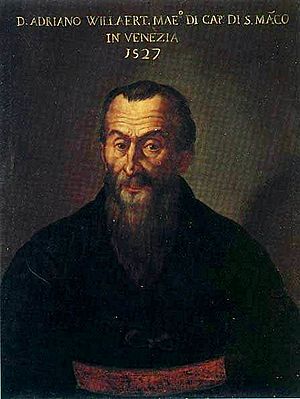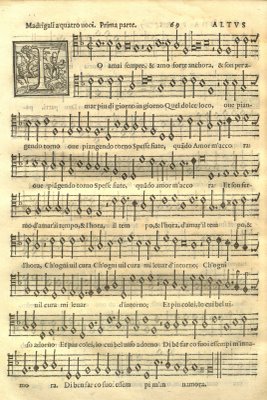Adrian Willaert facts for kids
Adrian Willaert (around 1490 – December 7, 1562) was a famous composer from the Flemish region. He lived during the time of the High Renaissance and mostly worked in Italy. Willaert is known as the founder of the Venetian School of music. He was one of the most important northern composers who moved to Italy and brought the complex Franco-Flemish style of music there.
Life
Adrian Willaert was born in a place called Rumbeke, near Roeselare. His student, Gioseffo Zarlino, who was a well-known music expert, said that Willaert first went to Paris to study law. But instead, he decided to study music. In Paris, he met Jean Mouton, a main composer for the French royal family. Mouton's style was similar to that of the famous composer Josquin des Prez. Willaert studied with him.
Around 1515, Willaert visited Rome for the first time. There's a story that shows how talented the young composer was. Willaert was surprised to hear the choir of the pope's chapel singing one of his own songs. It was probably a six-part song called Verbum bonum et suave. He was even more surprised because the choir thought the song was written by the much more famous Josquin des Prez. When Willaert told them he was the real composer, they refused to sing it again!
Willaert's early music style was very much like Josquin's. It had smooth polyphony (many voices singing together), balanced parts, and often used imitation (where one voice copies another). Willaert admired Josquin so much that he wrote a special mass, called Missa Mente Tota. This mass used a technique called "double canon" throughout, based on a part of a famous Josquin song.
In July 1515, Willaert started working for Cardinal Ippolito I d'Este in Ferrara. The Cardinal traveled a lot, and Willaert likely went with him to different places, including Hungary from 1517 to 1519. After Ippolito died in 1520, Willaert began working for Duke Alfonso of Ferrara. By 1522, Willaert had a job at the Duke's court chapel. He stayed there until 1525. Records show he then worked for Ippolito II d'Este in Milan.
Willaert's most important job was when he became the maestro di cappella (music director) at St. Mark's Basilica in Venice. This was one of the most important music jobs during the Renaissance. Music at St. Mark's had not been very good under the previous director. But that soon changed when Willaert arrived. The leader of Venice, Doge Andrea Gritti, played a big part in Willaert getting this job.
Willaert kept his job at St. Mark's from 1527 until he died in 1562. Composers from all over Europe came to Venice to study with him. He had very high standards for both singing and composing. From his earlier jobs with the dukes of Ferrara, he had made many important friends across Europe. This helped spread his fame and brought many musicians from other countries to northern Italy. Besides his church music, he also wrote many madrigals, which were popular secular (non-religious) songs. He is considered one of the best Flemish madrigal composers.
Musical Style and Influence
Willaert was one of the most flexible composers of the Renaissance. He wrote music in almost every style and form that existed then. Because of his strong personality and his important job at St. Mark's, he became the most influential musician in Europe. This was true between the time Josquin des Prez died and the time of Palestrina.
Some of Willaert's motets (religious songs) and French songs were published as early as 1520 in Venice. Willaert is very famous for his sacred (religious) music, especially his motets.
According to Gioseffo Zarlino, Willaert invented the antiphonal style. This style led to the polychoral (multiple choirs) style of the Venetian school. At St. Mark's, there were two choir lofts, one on each side of the main altar. Both had an organ. Willaert divided the choir into two groups. He would have them sing back and forth to each other (antiphonally) or sometimes sing together. Composers who came after Willaert, like De Rore, Zarlino, Andrea Gabrieli, and others, all used this style. The way Willaert wrote music at St. Mark's was continued by other composers there for a long time.
In 1550, Willaert published Salmi spezzati. These were psalm settings for two alternating choirs. This was the first famous polychoral work of the Venetian school. Willaert's religious music helped make Flemish music techniques a key part of the Venetian Style. While some research shows that others used this style before Willaert, his polychoral works were the first to become widely known and copied.
Willaert and other composers of his time also developed the canzone (a type of secular song) and ricercare. These were early forms of instrumental music. Willaert also arranged 22 four-part madrigals by Verdelot for voice and lute. In one of his early four-part vocal works, Quid non-ebrietas? (also called the Chromatic Duo), Willaert experimented with unusual musical notes. This was an early example of using chromaticism (using notes outside the main scale) in madrigals.
Willaert was also very good at teaching. Many famous composers were his students. These included Cipriano de Rore, who took over Willaert's job at St. Mark's, Costanzo Porta, Francesco Viola, Gioseffo Zarlino, and Andrea Gabrieli. Another composer influenced by Willaert was Lassus. These composers, except for Lassus, formed the main group of what became known as the Venetian School. This school had a huge impact on music and led to the start of the Baroque era. The Venetian School continued to be important for the rest of the 16th century and into the 17th century. Willaert also likely influenced a young Palestrina.
Willaert left behind many compositions. These include 8 (or possibly 10) masses, over 50 hymns and psalms, more than 150 motets, about 60 French chansons, over 70 Italian madrigals, and 17 instrumental pieces (like ricercares).
See also
 In Spanish: Adrian Willaert para niños
In Spanish: Adrian Willaert para niños



